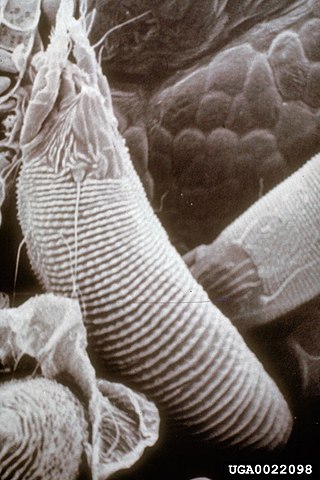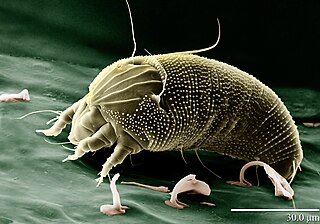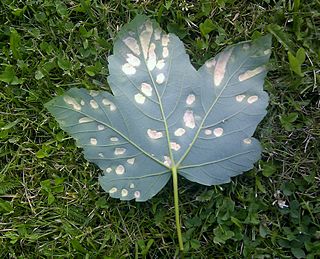
Galls or cecidia are a kind of swelling growth on the external tissues of plants, fungi, or animals. Plant galls are abnormal outgrowths of plant tissues, similar to benign tumors or warts in animals. They can be caused by various parasites, from viruses, fungi and bacteria, to other plants, insects and mites. Plant galls are often highly organized structures so that the cause of the gall can often be determined without the actual agent being identified. This applies particularly to some insect and mite plant galls. The study of plant galls is known as cecidology.

Eriophyidae is a family of more than 200 genera of mites, which live as plant parasites, commonly causing galls or other damage to the plant tissues and hence known as gall mites. About 3,600 species have been described, but this is probably less than 10% of the actual number existing in this poorly researched family. They are microscopic mites and are yellow to pinkish white to purplish in color. The mites are worm like, and have only two pairs of legs. Their primary method of population spread is by wind. They affect a wide range of plants, and several are major pest species causing substantial economic damage to crops. Some species, however, are used as biological agents to control weeds and invasive plant species.

Cecidophyopsis ribis is an eriophyid mite which is best known for being a plant parasite, a pest of Ribes species, the genus that includes gooseberries and blackcurrants. It is commonly known as the blackcurrant gall mite or big bud mite. It feeds on the plants' buds, forming galls, and transmits a virus which causes blackcurrant reversion disease. The mite is a serious pest of blackcurrant crops in Europe, but rarely on other continents.
Acalitus essigi, the redberry mite, is an eriophyid mite which is a serious pest of commercially produced blackberries in the United States. The redberry mite is microscopic, requiring at least a 20× hand lens to detect. It has two pairs of legs and a thin, translucent appearance.

Aceria chondrillae is a gall forming deuterogynous, eriophyid (mite) often used as a biological control of the noxious weed, Chondrilla juncea, a highly competitive herbaceous perennial composite found in Europe, Asia, Australia and North America.
Aceria malherbae is a species of gall mite known as the bindweed gall mite. It is used as an agent of biological pest control on invasive species of bindweed, particularly field bindweed.

Aceria is a genus of mites belonging to the family Eriophyidae, the gall mites. These tiny animals are parasites of plants. Several species can cause blistering and galls, including erineum galls. A few are economically significant pests, while others are useful as agents of biological pest control of invasive plants such as rush skeletonweed, creeping thistle, and field bindweed.

Aceria guerreronis, the coconut mite, is an eriophyid mite which infests coconut plantations. It is economically devastating, and can destroy up to 60% of coconut production. The immature nuts are infested and injured by mites feeding in the portion covered by the perianth of the immature nut.

Eriophyes is a genus of acari that forms galls, specially on trees of the family Rosaceae. Some are called blister mites. The blue butterfly Celastrina serotina has been reported to feed on these galls and also on the mites, making it one of the uncommon carnivorous Lepidoptera.

Aceria anthocoptes, also known as the russet mite, rust mite, thistle mite or the Canada thistle mite, is a species of mite that belongs to the family Eriophyidae. It was first described by Alfred Nalepa in 1892.

Vasates quadripedes, the maple bladder-gall mite, is an eriophyid mite in the genus Vasates, which causes galls on the leaves of silver maple, red maple (A. rubrum), and sugar maple (A. saccharum). The gall is rounded, sometimes elongate, and has a short, thin neck. Typically, galls are 2–3 millimetres (0.079–0.118 in) in diameter, and may be numerous on the upper surfaces of leaves. They have an opening in the lower surface. At first they are yellowish-green or bright red, later they become dark red and black.

Aceria pseudoplatani causes the sycamore felt gall that is found on the leaves of sycamores or Norway maple, and is caused by an acarine gall-mite.

Aceria fraxinivora, also known as the cauliflower gall mite and the ash key gall, causes the growths, known as galls, found on the hanging seeds or "keys" of the ash (Fraxinus) species.

Aceria tosichella, commonly known as the wheat curl mite (WCM), is a global cereal pest and a vector for spreading and transmission of viruses like wheat streak mosaic virus (WSMV) and wheat mosaic virus (WMoV)
Eriophyes tulipae, commonly known as the dry bulb mite, is a species of mite in the genus Eriophyes. This mite feeds on members of the lily family, and has damaged garlic crops. At one time, it was also thought to feed on wheat and other grasses, but the wheat curl mite is now regarded as a different species, Aceria tosichella.

Aceria nervisequa is a species of mite that belongs to the family Eriophyidae. It is found in Europe and was first described by Giovanni Canestrini in 1891. The mite causes galls on the leaves of beech,
Acalitus calycophthirus is an eriophyid mite which causes big bud galls on birch twigs. It is found in Europe and was first described by the Austrian zoologist, Alfred Nalepa in 1891.

Acalitus ferrugineum is a species of eriophyid mite. This microscopic organism induces erineum galls on the leaves of American beech, and is known from the United States and Canada.

Aceria fraxini, the ash bead gall mite, is a species of mites in the family Eriophyidae, the gall mites.













